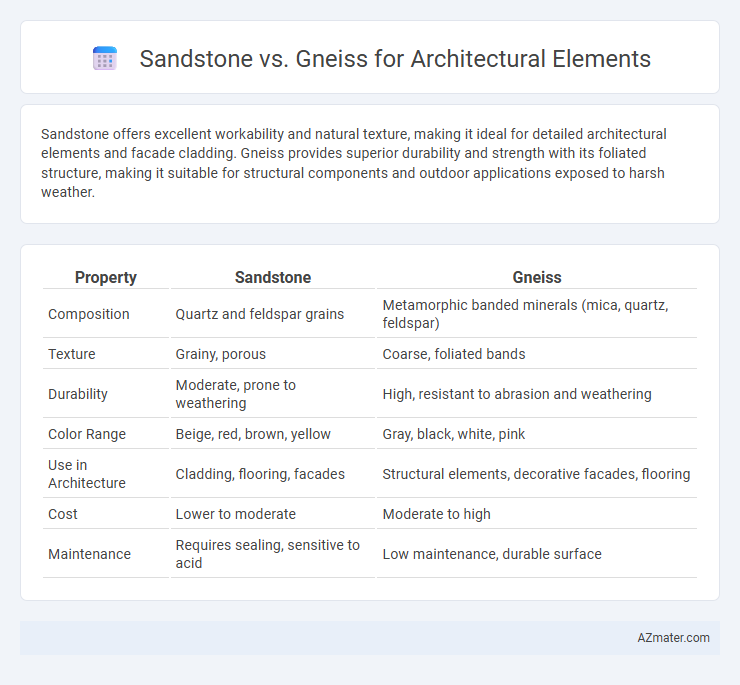Sandstone offers excellent workability and natural texture, making it ideal for detailed architectural elements and facade cladding. Gneiss provides superior durability and strength with its foliated structure, making it suitable for structural components and outdoor applications exposed to harsh weather.
Table of Comparison
| Property | Sandstone | Gneiss |
|---|---|---|
| Composition | Quartz and feldspar grains | Metamorphic banded minerals (mica, quartz, feldspar) |
| Texture | Grainy, porous | Coarse, foliated bands |
| Durability | Moderate, prone to weathering | High, resistant to abrasion and weathering |
| Color Range | Beige, red, brown, yellow | Gray, black, white, pink |
| Use in Architecture | Cladding, flooring, facades | Structural elements, decorative facades, flooring |
| Cost | Lower to moderate | Moderate to high |
| Maintenance | Requires sealing, sensitive to acid | Low maintenance, durable surface |
Introduction to Sandstone and Gneiss in Architecture
Sandstone, a sedimentary rock composed mainly of quartz and feldspar, offers excellent durability and natural earthy tones ideal for facade cladding and decorative elements in architecture. Gneiss, a metamorphic rock characterized by its foliated texture and distinct banding, provides superior strength and aesthetic appeal for structural components and interior accents. Both materials are favored in architectural design for their unique textures and weather resistance, making them versatile choices for various construction applications.
Geological Formation and Composition Differences
Sandstone forms through the compaction and cementation of sand-sized mineral particles, primarily quartz and feldspar, resulting in a porous and relatively soft sedimentary rock ideal for detailed carving in architectural elements. Gneiss develops from high-grade metamorphism of igneous or sedimentary rocks, exhibiting distinct foliation and banding due to mineral segregation, mainly composed of quartz, feldspar, and mica, offering superior strength and durability for structural applications. The key geological formation difference is that sandstone is sedimentary, formed from sediment deposition, while gneiss is metamorphic, transformed by intense heat and pressure, directly influencing their composition, texture, and suitability in architecture.
Aesthetic Appeal and Visual Characteristics
Sandstone offers a warm, earthy aesthetic with natural stratified layers and rich color variations ranging from beige to red, creating a rustic and inviting architectural element. Gneiss features a more dramatic visual appeal characterized by its foliated texture and alternating light and dark mineral bands, adding sophistication and a striking, dynamic pattern to building facades. Both stones provide unique visual textures, but sandstone emphasizes warmth and softness, while gneiss enhances elegance and bold contrast in design.
Durability and Weather Resistance Comparison
Sandstone exhibits moderate durability with a porous structure that can absorb moisture, making it susceptible to weathering and erosion over time, particularly in harsh climates. Gneiss, a metamorphic rock with a dense, foliated composition, offers superior durability and excellent weather resistance, maintaining structural integrity under extreme environmental conditions. The high resistance of gneiss to freeze-thaw cycles and abrasion makes it a preferred choice for long-lasting architectural elements exposed to the elements.
Workability and Ease of Installation
Sandstone offers superior workability due to its softer composition, allowing for easier cutting, shaping, and carving, which significantly reduces installation time and labor costs in architectural elements. Gneiss, while more durable and resistant to weathering, presents challenges during installation because of its hardness and difficulty in processing, often requiring specialized tools and skilled craftsmanship. For projects prioritizing ease of installation and intricate designs, sandstone is typically the preferred material, whereas gneiss suits applications demanding long-term durability despite a more complex installation process.
Cost Analysis and Economic Considerations
Sandstone generally offers a lower cost for architectural elements due to its abundance and easier quarrying process compared to gneiss, which is denser and requires more labor-intensive extraction. Gneiss, known for its durability and distinctive foliation, commands higher prices reflecting its superior structural properties and aesthetic appeal in high-end projects. Economic considerations favor sandstone for budget-conscious constructions, while gneiss suits applications demanding long-term resilience despite higher initial investment.
Environmental Impact and Sustainability
Sandstone is a sedimentary rock with lower energy-intensive extraction processes and better natural weathering properties, making it a more sustainable choice for architectural elements. Gneiss, a metamorphic rock, requires significant energy for quarrying and processing, resulting in higher carbon emissions. The environmental impact of using sandstone is generally lower due to its abundant availability and ease of recycling in construction projects.
Popular Uses in Modern Architectural Elements
Sandstone is commonly utilized for cladding, flooring, and decorative facades due to its durability and natural aesthetic appeal in modern architecture. Gneiss is favored for its strength and distinctive banded patterns, making it ideal for countertops, wall panels, and exterior paving. Both materials enhance architectural elements by combining visual texture with structural resilience, catering to contemporary design trends that emphasize natural stone finishes.
Maintenance Requirements and Longevity
Sandstone offers moderate durability but requires regular sealing and cleaning to prevent erosion and staining, making its maintenance more intensive compared to gneiss. Gneiss boasts higher density and hardness, resulting in superior resistance to weathering and minimal upkeep, ideal for long-lasting architectural elements. Its natural interlocking mineral grains enhance structural integrity, ensuring longevity with less frequent maintenance.
Choosing the Right Stone for Architectural Projects
Sandstone offers a warm, natural aesthetic with excellent workability, making it ideal for intricate carvings and decorative facades in architectural projects. Gneiss, known for its strength and distinctive banded texture, provides superior durability and weather resistance, suitable for structural elements and exterior cladding. Selecting between sandstone and gneiss depends on project requirements such as desired visual appeal, load-bearing capacity, and environmental exposure to ensure longevity and design integrity.

Infographic: Sandstone vs Gneiss for Architectural Element
 azmater.com
azmater.com